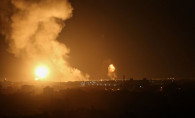Baba Gurgur: The restless flames in Iraq
Baba Gurgur: The restless flames in Iraq
The “eternal” flames of Baba Gurgur have been burning for thousands of years. Baba Gurgur was thought to be the world's largest oil field before the Ghawar field in Saudi Arabia was discovered in 1948.
History
First discovered in northern Iraq in 1927, Baba Gurgur is a huge oil field close to the city of Kirkuk. It is well-known for the Eternal Fire, which is thought to have been blazing for more than 4,000 years and is situated in the center of its oil fields, according to Amusing Planet.
The name means “Father of Eternal Fire” in Kurdish. Gases far below the earth's surface are the origin of the rumbling that finally led a team to begin searching for one of the planet’s most valuable resources, the National News reported.
The Turkish Petroleum Company discovered oil in Baba Gurgur on the evening of October 15, 1927, making it Iraq's first modern oil well. As hundreds of barrels of oil flowed out, flooding a valley known as Wadi Naft that transported water down the low foothills, the discovery quickly became a serious environmental problem. Crude oil was leaking into the wide open desert, endangering the lives of the locals, their homes, and the water supply, according to Amusing Planet.
As a result, quick action was taken to stop the oil spill, but lives were also lost in the process. By the time the well was plugged, 95,000 barrels of oil had leaked into the area's desert ecosystem. It became necessary to remove the accumulated oil as the rainy season drew near, leading to attempts to pump oil back into the wells. When these efforts were unsuccessful, massive amounts of oil were set on fire, which successfully burned off the oil prior to the start of the rains, World Atlas reported.
Myths
The “eternal” flames of Baba Gurgur continued to burn for countless years, igniting myths, fostering hope, and providing plain warmth.
The Baba Gurgur is mentioned in the writings of numerous ancient authors, including Herodotus. Some people even think that the perpetual fire is the one that was depicted in the Old Testament's Book of Daniel, acting as the location where King Nebuchadnezzar of Babylon executed three Jewish youths for disobeying his instructions to worship idols. Shepherds would warm themselves and their sheep by the fire, and it plays a significant role in the life of the inhabitants, World Atlas reported.
Women believed the flames had magical abilities and would request the birth of a boy rather than a girl, according to the National News.
Tourist destination
World Atlas said that the most significant oil fields in northern Iraq are located near Baba Gurgur. Nearly half of all the oil exported from Iraq comes from these oil fields, which produce roughly 10 billion barrels of oil per day. The Kirkuk-Ceyhan Oil Pipeline carries the oil from this location to Ceyhan, a Turkish port in the Mediterranean. Extremely hot and dry summers and cold, rainy winters are hallmarks of the climate that prevails in and around Baba Gurgur.
Moreover, visitors travel to Baba Gurgur to see the famous Eternal Fire. Tourists can reach this location from the city of Kirkuk by taking a short walk. However, because oil is mined nearby, a large area of the land next to Baba Gurgur is closely supervised with a heavy security presence. The closest city, Kirkuk, is home to a large ethnic diversity, including Kurds, Turks, Arabs, Assyrians, Armenians, and Jews, as well as a large number of ancient and touristic monuments.







